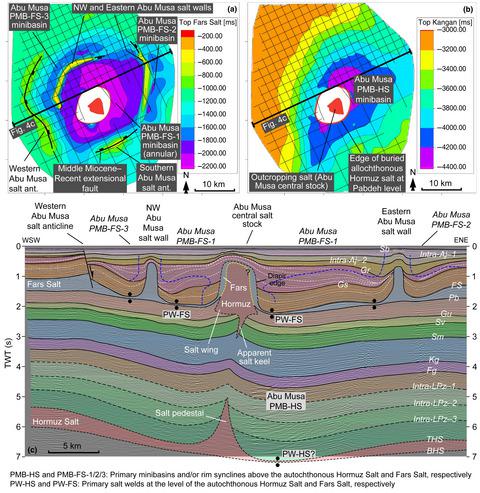当前位置:
X-MOL 学术
›
Basin Res.
›
论文详情
Our official English website, www.x-mol.net, welcomes your
feedback! (Note: you will need to create a separate account there.)
Salt tectonics in a double salt‐source layer setting (Eastern Persian Gulf, Iran): Insights from interpretation of seismic profiles and sequential cross‐section restoration
Basin Research ( IF 2.8 ) Pub Date : 2020-04-29 , DOI: 10.1111/bre.12459 Jafar Hassanpour 1 , Ali Yassaghi 1 , Josep A. Muñoz 2 , Salman Jahani 3
Basin Research ( IF 2.8 ) Pub Date : 2020-04-29 , DOI: 10.1111/bre.12459 Jafar Hassanpour 1 , Ali Yassaghi 1 , Josep A. Muñoz 2 , Salman Jahani 3
Affiliation

|
Salt tectonics in the Eastern Persian Gulf (Iran) is linked to a unique salt‐bearing system involving two overlapping ‘autochthonous’ mobile source layers, the Ediacaran–Early Cambrian Hormuz Salt and the Late Oligocene–Early Miocene Fars Salt. Interpretations of reflection seismic profiles and sequential cross‐section restorations are presented to decipher the evolution of salt structures from the two source layers and their kinematic interaction on the style of salt flow. Seismic interpretations illustrate that the Hormuz and Fars salts started flowing in the Early Palaeozoic (likely Cambrian) and Early Miocene, respectively, shortly after their deposition. Differential sedimentary loading (downbuilding) and subsalt basement faults initiated and localized the flow of the Hormuz Salt and the related salt structures. The resultant diapirs grew by passive diapirism until Late Cretaceous, whereas the pillows became inactive during the Mesozoic after a progressive decline of growth in the Late Palaeozoic. The diapirs and pillows were then subjected to a Palaeocene–Eocene contractional deformation event, which squeezed the diapirs. The consequence was significant salt extrusion, leading to the development of allochthonous salt sheets and wings. Subsequent rise of the Hormuz Salt occurred in wider salt stocks and secondary salt walls by coeval passive diapirism and tectonic shortening since Late Oligocene. Evacuation and diapirism of the Fars Salt was driven mainly by differential sedimentary loading in annular and elongate minibasins overlying the salt and locally by downslope gliding around pre‐existing stocks of the Hormuz Salt. At earlier stages, the Fars Salt flowed not only towards the pre‐existing Hormuz stocks but also away from them to initiate ring‐like salt walls and anticlines around some of the stocks. Subsequently, once primary welds developed around these stocks, the Fars Salt flowed outwards to source the peripheral salt walls. Our results reveal that evolving pre‐existing salt structures from an older source layer have triggered the flow of a younger salt layer and controlled the resulting salt structures. This interaction complicates the flow direction of the younger salt layer, the geometry and spatial distribution of its structures, as well as minibasin depocentre migration through time. Even though dealing with a unique case of two ‘autochthonous’ mobile salt layers, this work may also provide constraints on our understanding of the kinematics of salt flow and diapirism in other salt basins having significant ‘allochthonous’ salt that is coevally affected by deformation of the deeper autochthonous salt layer and related structures.
中文翻译:

双重盐源层环境中的盐构造(伊朗东部波斯湾):地震剖面解释和相继断面复原的见解
东波斯湾(伊朗)的盐构造与一个独特的含盐系统相关,该系统包含两个重叠的“自生土”。移动源层,即Ediacaran-早寒武纪Hormuz盐和晚渐新世-早中新世Fars盐。给出了反射地震剖面的解释和相继的剖面复原,以解释两个源层的盐结构演化及其在盐流方式上的运动学相互作用。地震解释表明,霍尔木兹盐和法尔斯盐在沉积后不久就分别开始在古生代早期(可能是寒武纪)和中新世早期流动。差异性的沉积载荷(下沉)和盐下基底断裂引发了霍尔木兹盐及相关盐构造的流动并将其局部化。产生的底盘通过被动底盘发育而增长,直到白垩纪晚期,而后古生代的生长逐渐下降后,枕头在中生代变得无效。然后,对墩和枕进行了古新世-始新世的收缩变形事件,挤压了墩。结果是大量的盐挤出,导致了异方盐板和机翼的发展。后来的渐新世以来,由于被动消极的二叠纪和构造缩短,霍尔木兹海盐随后在较宽的盐储量和次生盐壁中发生。Fars盐的疏散和透水作用主要是由于盐上方的环形和细长小盆地中不同的沉积负荷所致,局部是通过在Hormuz盐的原有种群周围滑行而引起的。在早期阶段 Fars Salt不仅流向了先前存在的Hormuz种群,还流离了它们,从而在某些种群周围引发了环状的盐壁和背斜。随后,一旦围绕这些水库的初级焊缝发展起来,Fars Salt便向外流出,以寻找外围的盐壁。我们的结果表明,从较旧的源层演化而来的盐结构已经触发了较年轻的盐层的流动,并控制了所得盐结构。这种相互作用使较年轻的盐层的流动方向,其结构的几何形状和空间分布以及随时间推移的小流域沉积中心的迁移变得复杂。即使处理两个的独特情况 一旦围绕这些水库的主要焊缝发展起来,Fars Salt便向外流动以寻找外围的盐壁。我们的结果表明,从较旧的源层演化而来的盐结构已经触发了较年轻的盐层的流动,并控制了所得盐结构。这种相互作用使较年轻的盐层的流动方向,其结构的几何形状和空间分布以及随时间推移的小流域沉积中心的迁移变得复杂。即使处理两个的独特情况 一旦围绕这些水库的主要焊缝发展起来,Fars Salt便向外流动以寻找外围的盐壁。我们的结果表明,从较旧的源层演化而来的盐结构已经触发了较年轻的盐层的流动,并控制了所得盐结构。这种相互作用使较年轻的盐层的流动方向,其结构的几何形状和空间分布以及随时间推移的小流域沉积中心的迁移变得复杂。即使处理两个的独特情况 这种相互作用使较年轻盐层的流动方向,其结构的几何形状和空间分布以及随时间推移的小流域沉积中心的迁移变得复杂。即使处理两个的独特情况 这种相互作用使较年轻的盐层的流动方向,其结构的几何形状和空间分布以及随时间推移的小流域沉积中心的迁移变得复杂。即使处理两个的独特情况在``自生''流动盐层中,这项工作也可能会限制我们对其他具有显着``散发性''盐的盐盆地的盐流运动和成岩作用的理解,这些盐显然受到深层自生盐层和相关结构变形的影响。
更新日期:2020-04-29
中文翻译:

双重盐源层环境中的盐构造(伊朗东部波斯湾):地震剖面解释和相继断面复原的见解
东波斯湾(伊朗)的盐构造与一个独特的含盐系统相关,该系统包含两个重叠的“自生土”。移动源层,即Ediacaran-早寒武纪Hormuz盐和晚渐新世-早中新世Fars盐。给出了反射地震剖面的解释和相继的剖面复原,以解释两个源层的盐结构演化及其在盐流方式上的运动学相互作用。地震解释表明,霍尔木兹盐和法尔斯盐在沉积后不久就分别开始在古生代早期(可能是寒武纪)和中新世早期流动。差异性的沉积载荷(下沉)和盐下基底断裂引发了霍尔木兹盐及相关盐构造的流动并将其局部化。产生的底盘通过被动底盘发育而增长,直到白垩纪晚期,而后古生代的生长逐渐下降后,枕头在中生代变得无效。然后,对墩和枕进行了古新世-始新世的收缩变形事件,挤压了墩。结果是大量的盐挤出,导致了异方盐板和机翼的发展。后来的渐新世以来,由于被动消极的二叠纪和构造缩短,霍尔木兹海盐随后在较宽的盐储量和次生盐壁中发生。Fars盐的疏散和透水作用主要是由于盐上方的环形和细长小盆地中不同的沉积负荷所致,局部是通过在Hormuz盐的原有种群周围滑行而引起的。在早期阶段 Fars Salt不仅流向了先前存在的Hormuz种群,还流离了它们,从而在某些种群周围引发了环状的盐壁和背斜。随后,一旦围绕这些水库的初级焊缝发展起来,Fars Salt便向外流出,以寻找外围的盐壁。我们的结果表明,从较旧的源层演化而来的盐结构已经触发了较年轻的盐层的流动,并控制了所得盐结构。这种相互作用使较年轻的盐层的流动方向,其结构的几何形状和空间分布以及随时间推移的小流域沉积中心的迁移变得复杂。即使处理两个的独特情况 一旦围绕这些水库的主要焊缝发展起来,Fars Salt便向外流动以寻找外围的盐壁。我们的结果表明,从较旧的源层演化而来的盐结构已经触发了较年轻的盐层的流动,并控制了所得盐结构。这种相互作用使较年轻的盐层的流动方向,其结构的几何形状和空间分布以及随时间推移的小流域沉积中心的迁移变得复杂。即使处理两个的独特情况 一旦围绕这些水库的主要焊缝发展起来,Fars Salt便向外流动以寻找外围的盐壁。我们的结果表明,从较旧的源层演化而来的盐结构已经触发了较年轻的盐层的流动,并控制了所得盐结构。这种相互作用使较年轻的盐层的流动方向,其结构的几何形状和空间分布以及随时间推移的小流域沉积中心的迁移变得复杂。即使处理两个的独特情况 这种相互作用使较年轻盐层的流动方向,其结构的几何形状和空间分布以及随时间推移的小流域沉积中心的迁移变得复杂。即使处理两个的独特情况 这种相互作用使较年轻的盐层的流动方向,其结构的几何形状和空间分布以及随时间推移的小流域沉积中心的迁移变得复杂。即使处理两个的独特情况在``自生''流动盐层中,这项工作也可能会限制我们对其他具有显着``散发性''盐的盐盆地的盐流运动和成岩作用的理解,这些盐显然受到深层自生盐层和相关结构变形的影响。











































 京公网安备 11010802027423号
京公网安备 11010802027423号